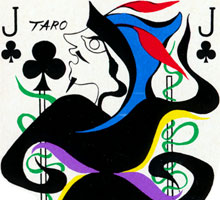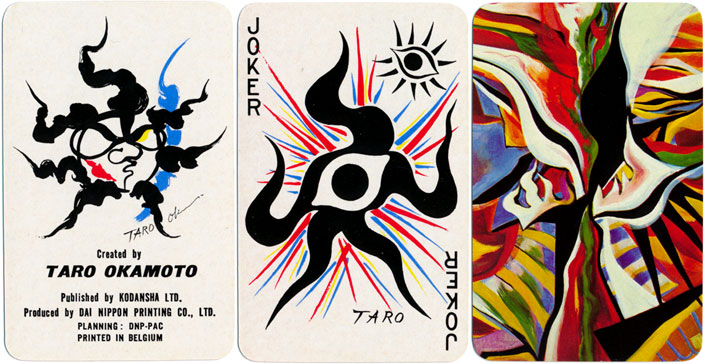Taro Okamoto
The combination of shapes and colours in these playing cards creates a vibrant and eye-catching surreal effect.

Taro Okamoto Playing Cards, 1977
Japanese artist Taro Okamoto (1911-1996) was noted for his abstract and avant-garde paintings and sculpture. The combination of shapes and colours in these playing cards creates a vibrant and eye-catching surreal effect. One of Okamoto's famous works, Tower of the Sun, became the symbol of Expo '70 in Suita, Osaka, 1970. During the 1970s Okamoto was also working as a muralist and designer whilst continuing to create and exhibit new works. His mural "The Myth of Tomorrow" (2008) depicts a human figure being hit by an atomic bomb.


Above: Taro Okamoto playing cards, 1977. 52 cards + 2 Jokers in box. The artist's name 'Taro' appears on all the court cards.
Born in Tokyo, Taro Okamoto (1911-1996) was the eldest son of cartoonist Ippei Okamoto and the poet and novelist Kanoko Okamoto. In 1941 he was awarded the Japanese Nika Prize.
Okamoto served in the military from 1942-1946, returning to Tokyo to find many of his paintings burned in an air raid. In 1948, he began to explore the integration of avant-garde art and literature. One of Okamoto's famous works, Tower of the Sun, became the symbol of Expo '70 in Suita, Osaka, 1970. On November 17, 2008, his mural "The Myth of Tomorrow", depicting a human figure being hit by an atomic bomb, was unveiled in Tokyo.
Images courtesy Barney Townshend.
Illuminated capital 'J' by Kathryn Finter.

By Barney Townshend
Member since October 06, 2015
Retired Airline Pilot, interested in: Transformation Playing Cards, Karl Gerich and Elaine Lewis. Secretary of the EPCS. Treasurer of the IPCS.
Related Articles

Dancing
“Dancing” playing cards manufactured by Nintendo for Torii Dance School, Osaka.

Tactics Design
Late modernist Japanese playing cards designed by Masayoshi Nakajo for Tactics Design.

Dragon Quest
Card game based on the Japanese video game series with character illustrations by Akira Toriyama

Morinaga Hakuho playing cards
Artistic playing cards attributed to Morinaga Hakuho and printed by Nintendo, c.1985.

Shin-Tōmei Expressway Opening Commemoration
Promotional playing cards for the Shin-Tōmei Expressway, a major Japanese expressway that opened in ...

Hana-Trump トランプ
Hana-Trump cards from Japan are Hana-Fuda flower cards with miniature international playing cards in...

Mahjong-Trump playing cards
Mahjong tiles integrated with international playing cards.

Japanese Beauties
An elegant fusion of Western and Japanese traditions modelled after ukiyo-e.

Sunday Night / Nichiyoubi no Yoru
An irreverent, avant-garde deck unofficially titled "Nichiyoubi no Yoru" (Sunday Night), designed by...

Angel 52 Secrets
Vintage “52 Secret” art deco-inspired playing cards from Japan.

Banjo Cards
Images of the peg heads from 4-string banjos from Akira Tsumura’s renowned collection.

Tarot de Valverde de la Vera
A series of 24 surrealist engravings by Mexican artist Claudio Favier in which archetypal Tarot alle...

Eki karuta
Japanese fortune-telling cards based on I Ching, with bold, modern designs.

SCOR playing cards
Bizarre and fantastical images by the artist Roland Topor for the SCOR reinsurance company.

Karl Korab
Austrian artist Karl Korab’s first pack, displaying his use of different techniques.

Iroha Karuta for Hino City
Special version of Iroha Karuta, a traditional Japanese matching game, made for Hino City, Tokyo.
Most Popular
Our top articles from the past 28 days

